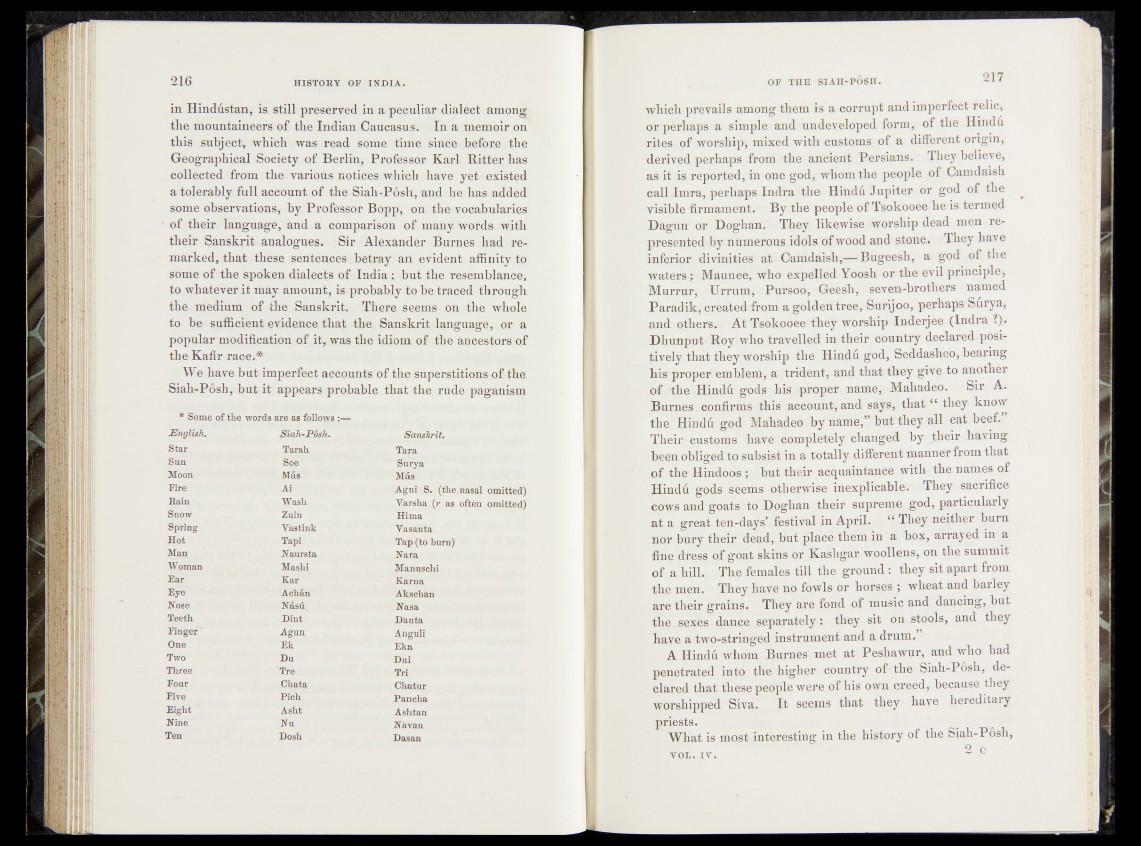
in Hindustan, is still preserved in* a peculiar dialect among
the mountaineers of the Indian Caucasus,. In a memoir on
this subject, which was read Some time since, before,, the
Geographical Society of Berlin, Professor Karl Hitter has
collected from the. various notices which have yet existed
a tolerably full account of the Siah-Pósh, and he has added
some observations, by Professor Bopp, on the vocabularies
of their language, and a comparison of many words with
their Sanskrit analogues. Sir Alexander Burnes had remarked*
that these sentences betray an evident, affinity ter
some of the spoken dialects of India ;«>but the; resemblance!
to whatever it may amount, is probably té be traced through
the medium of the Sanskrit. There seems on the whole
to be sufficient evidence that the Sanskrit language, or a
popular modification of it,was the idiom of the ancesfor'sef
the Kafir race.*
We have but imperfect accounts of the superstitions-^f* the
Siah-Pósh, but it appears probable-that the rede .paganism
* Some of the words are as follows :-faaa
English. Siah-Pôsh. »: Sanskrit.
Star Tarah '. Tara
San Soe Surya
Moon Mas - Mas
Fire Ai jj !Agni S. r (the. nasal omitted)
Rain Wash Varsha (r as often, opâfted)
Snow Zuin . Hima
Spring Vastink Vasanta
Hot Tapi Tap (to h u a h )^ i
Man Nanrsta . Nftra,
Woman Mashi Manuschi
Ear Ka» Kama
Eye A chân Akschan
Hose Nâsû Nasa
Teeth Dint Danta
Finger ‘ Agon Anguli
One Ek Eka
Two Du Dui
Three Tre Tri
Fonr Chata Chatuï
Five Pich Pancha
Eight ' Asht Ashtan
Nine Nu Navan
Ten Dosh .. Dasan
which prevail» among them is à corrupt and imperfect relic,
or perhaps a simpip? and undeveloped, form * of the Hindu
rites of worship*, mixed with customs of a different origin,
derivedperhaps. from the ancient Persians. They believe,
ai it i^reported, in one gód?'whom the people of Camdaish
call Imra, perhaps Indra -the Hindu Jupiter or god of the
visible firmament. By the people of Tsokooee he is termed
Hagun or Doghan. Theylikewiseworship dead men represented
by numerous idols of wood and stone. They bave
inferior divinities' ate Canidaisb^- Bugeesh, a god of the
waters ;wMaunèe£Îwho expelled. Yoosh or the evil principle,
Murrur,' Wrrum, Pursoo, * Geesh, seven-brothers named
Parad ife^created from agolden tree, Burijoo, perhaps Surya,
and others*-, At Tsokooee they worship Inderjèe (Indra ?).
Dhunpiite Roy who travelled in their country declared positively
that they worship the Ilindû god, Seddasheo, bearing
bis proper'émblem, a trident, and that they give to another
of .the; Hindû gods his proper name, Mahadeo.. Sir A.
Burnes. confirms this account-, and says, that “ they know
the Hindu god Mahadeo by name,” hut they-all eat beef.
Their- qdstoms have completely changed by their having
l^eeïi. obliged to subsist in a totally different manner from that
of 'tbes Hindoos but their acquaintance with the names of
Hinéû? gods seems otherwise inexplicable. They sacrifice
cows and goats to Doghan their supreme god, particularly
at a great tep-days’ festival in April. “ They neither burn
nor bury their dead,'but place them in a box, arrayed in a
fine dress of goat skins or Kashgar woollens, on the summit
of a hill. The females till the ground : they sit apart from
the men. They have no fowls or horses ; wheat and barley
are their grains. They are fond, of music and dancing, but
the sexes dance separately : they sit on stools, and they
have a two-stringed instrument and a drum.
A Hindû whom Burnes met at Peshawur, and who had
penetrated into the higher country of the Siah-Pôsh, declared
that these people were of his own creed, because they
worshipped Siva. It seems that they have hereditary
priests.
What is most interesting in the history of the Siah-Pôsh,
VO L .iv. > 2^ ^c